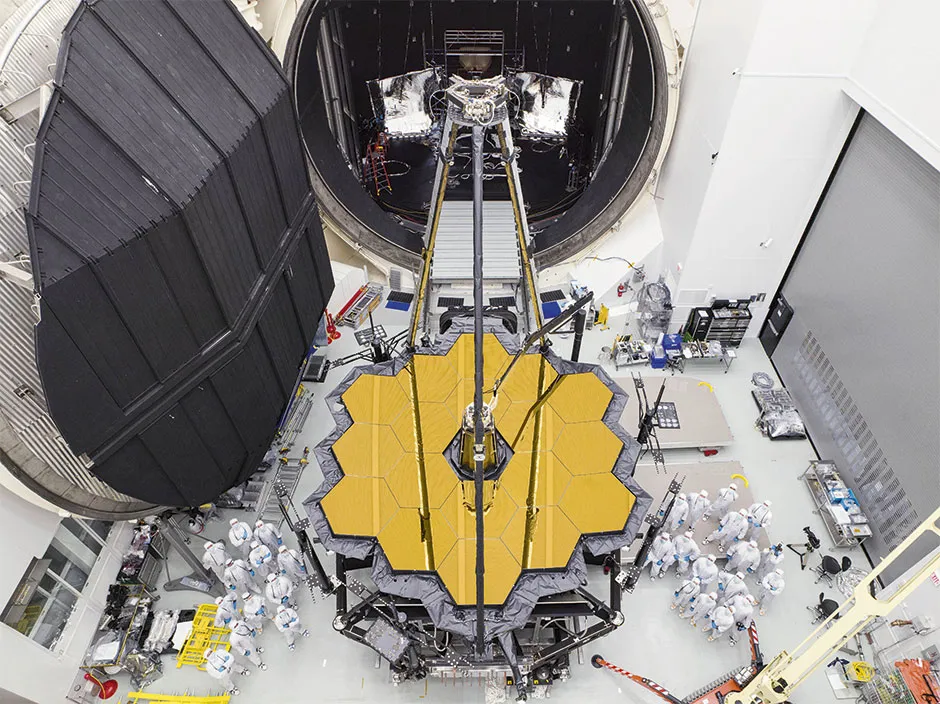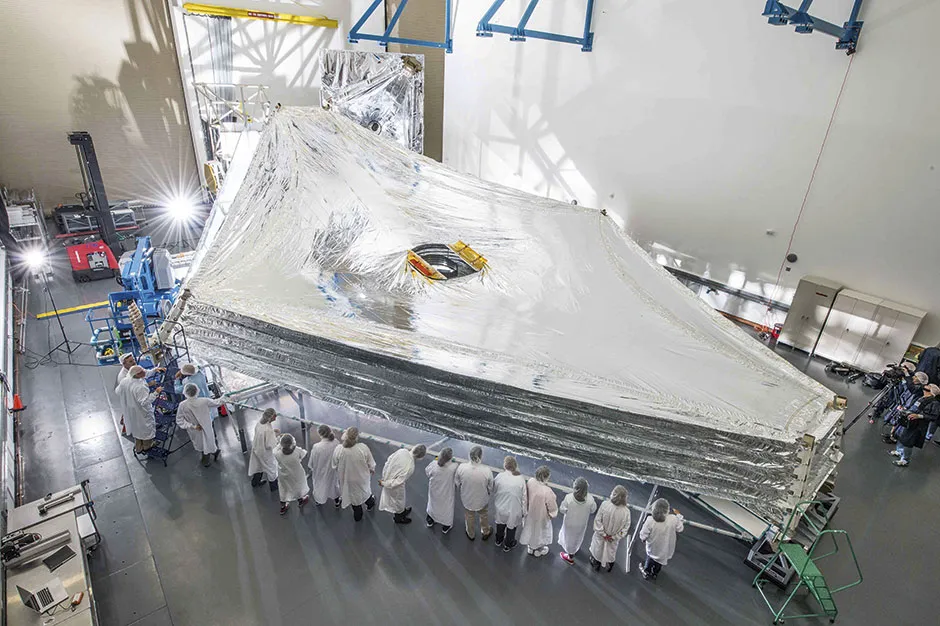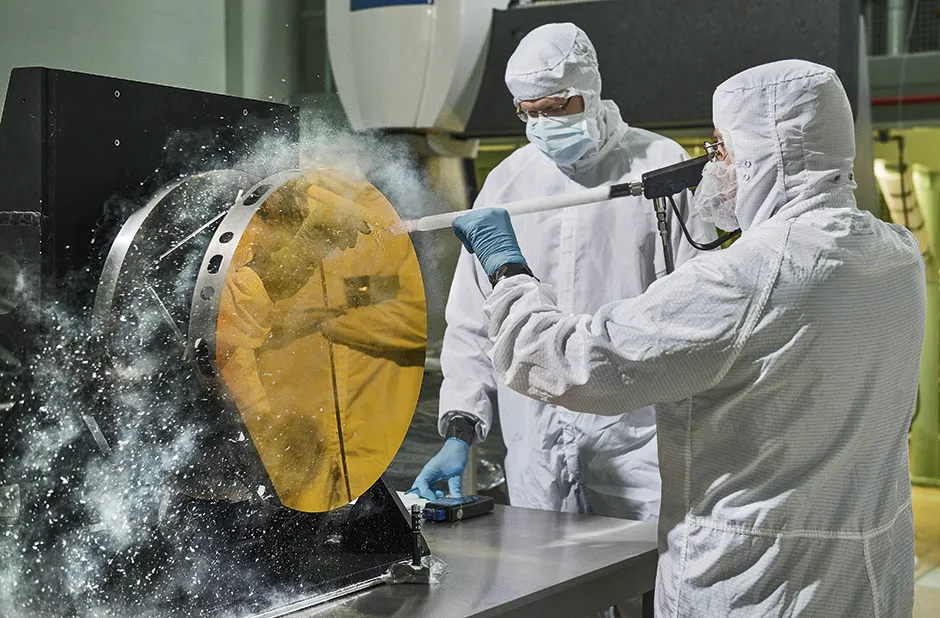After nearly 20 years of development and 16 launch delays, the James Webb Space Telescope (JWST) is almost ready. Set to launch on 31 October 2021, the largest space observatory ever built is set to revolutionise our understanding of the cosmos and help solve some of the Universe’s greatest mysteries.
It hasn’t been an easy journey. First conceived 30 years ago as the successor to the Hubble Space Telescope, the ‘Next Generation Telescope’ as the JWST was first known, has survived threats of cancellation, changes of leadership and numerous postponements. Expected to cost $10bn (£7.2bn approx), the JWST (named after NASA’s second administrator James E Webb) is the sixth most expensive space mission of all time.
And it’s not surprising: the JWST is brimming with innovation and complexity, is the product of a large international collaboration between the US, European and Canadian space agencies, and is often described as one of NASA’s biggest and boldest undertakings, one that will contribute unparalleled value to science and technology.

For over 25 years, Hubble has graced us with beautiful images of the 13.8-billion-year-old Universe, capturing light emitted just 500 million years after the Big Bang. JWST’s infrared ‘eyes’ will be able to peer even further into the Universe’s early history, back to when the first stars and galaxies were born.
The telescope will also venture further from Earth than its predecessor. While Hubble follows a close orbit, around 550km above Earth, the JWST will float up to 1.5 million kilometres from us and orbit the Sun. It will cast its gaze on the likes of Mars, comets, dwarf planets and exoplanets, to teach us more about how planets and solar systems form.
Hubble isn’t the only telescope the JWST will surpass though; it’ll eclipse another great space observatory too: Spitzer (launched in 2003 and retired in early 2020). As Naomi Rowe-Gurney, a planetary scientist at the University of Leicester explains: “Data from Spitzer has shown some really unexpected behaviour happening on Uranus and we have no idea what’s causing it. The only way wecan find out is by using the JWST’s power and infrared capabilities.”
Read more about telescopes:
- Eye on the sky: The ground-based telescopes bringing the Universe down to Earth
- SKA: A new eye on the Universe
- How the Parker Solar Probe will 'touch the Sun'
The JWST will also deepen our knowledge of exoplanets. “We’re finding more exoplanets with the same masses as our ice giants, Uranus and Neptune. Because we don’t know much about the ice giants in our Solar System, we can’t understand those in other planetary systems. The JWST is definitely going to change how we view our Solar System,”
says Rowe-Gurney.
Looking at the telescope towering over engineers at NASA’s Johnson Space Center in Houston, Texas, you can see why it’s a game-changer. The JWST’s primary mirror is a thing of beauty. Its honeycomb structure is an impressive 6.5m in diameter and made up of 18 adjustable, gold-plated beryllium segments. Compared to Hubble, the JWST has six times the light-collecting area and a much wider field of view (roughly 15 times larger). Yet, at 6,500kg, it’s almost half the mass.
The light captured by the optics will be analysed by the four science instruments on board – collectively known as the Integrated Science Instrument Module (ISIM). The optical mechanisms need to be kept below -223°C to maximise the chances of detecting faint traces of infrared light.

The Mid-Infrared Instrument (MIRI) requires an even lower temperature of -266°C, barely above absolute zero. To prevent the Sun’s heat and light from interfering with its observations, the JWST is equipped with cryocoolers and a five-layer, tennis-court-sized sunshield.
Despite its huge size, the entire observatory must fold down to fit inside an Ariane 5 rocket’s nose cone. Once deployed, the JWST will unfold itself, cool down and calibrate. Mission success hinges on flawless execution of this sequence, one which has never before been attempted in space.
To add even more jeopardy, the JWST will be beyond the reach of crewed repair missions, unlike Hubble, which needed five. This is why testing has been of the highest importance for the mission team every step of the way.

But, according to Paul Geithner, JWST’s technical deputy project manager, assessing an observatory designed to deploy and operate in space is no easy feat. “We could not test the entire observatory as one complete entity in a simulated space environment – it’s a departure from the early days of the space age when you could put an entire spacecraft into a thermal vacuum chamber and test it all at once,” he explains.
Instead, individual units, built in different parts of the world, were tested before they were brought together and assembled into two ‘super-halves’, comprising the Optical Telescope element/Integrated Science instrument module (OTIS), and the combined spacecraft bus and sunshield.
Each unit was tested in acoustic and vibration chambers that replicated a violent, noisy launch, and also placed into a large freezer, known as ‘Chamber A’, for months to check they could withstand the freezing temperatures of space.
There have been some bumps on this long road, such as loose fastening screws found after acoustic and vibration testing in 2016, and, most notably, the sunshield ripping after a test deployment in March 2018. “Cutting-edge engineering of new spaceflight hardware is a humbling business,” Geithner reflects.

In August 2019, the two super-halves were combined at a Northrop Grumman facility in California to undergo full integration testing. And in 2020, during the COVID-19 pandemic, the fully assembled JWST accomplished an astounding feat: it passed every single test.
Granted, prior to the testing success the JWST’s launch was postponed once again. But this time it was only from March to October 2021 – a reasonable delay considering the team has had to work remotely and in socially distanced shifts, during a critical phase.
With only months left until the JWST launches from French Guiana, Geithner now has time to reflect on the power of the project so far: “While the JWST is to be a tool of science and has been a daunting engineering challenge, it is, in the end, a human story, a generational project.” Indeed, there is no doubt the discoveries it could make will serve generations to come.
- This article first appeared inissue 362ofBBC Science Focus Magazine–find out how to subscribe here